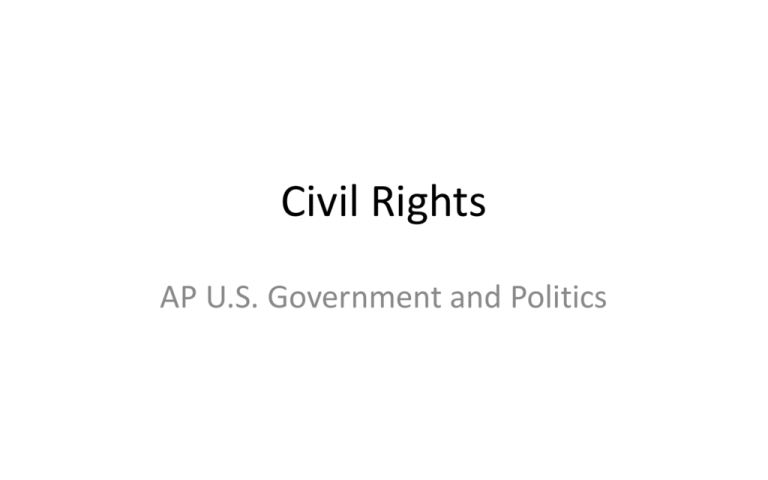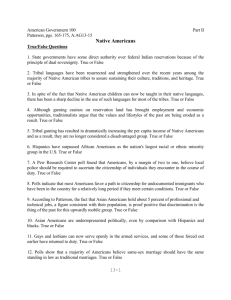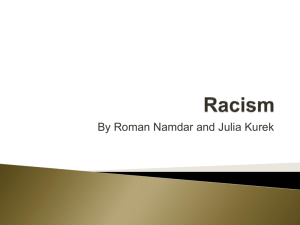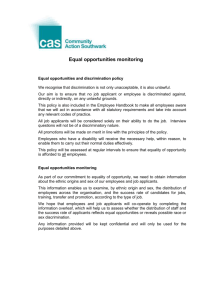Civil Rights
advertisement

Civil Rights AP U.S. Government and Politics Civil Rights – Civil rights or equal rights – the right of every person to equal protection under the laws and equal access to society’s opportunities and public facilities. • Throughout American history, disadvantaged groups have rarely achieved a measure of equality without a struggle. – The equal-protection clause of the Fourteenth Amendment forbids states to deny equal protection of the laws to any individual within its jurisdiction. • After Federal Troops withdrew from the South in 1877, white majorities enacted laws that prohibited blacks from using the same facilities as whites. – Plessy v. Ferguson (1896) – Supreme Court endorsed these laws through the “separate but equal” justification. Segregation in Schools • Substantial intervention finally occurred for African Americans with Brown v. Board of Education of Topeka (1954). – Brown overturned Plessy v. Ferguson’s concept of “separate but equal.” • The decision led to outrage in the south, with some southerners pushing for the impeachment of Chief Justice Earl Warren. • 1954 Gallup Poll showed that a sizeable majority of Southern whites were opposed to the Brown decision. – Brown v. Board of Education (1955) focused on the implementation of desegregation of public schools. • Today, America’s schools are actually becoming less diverse. Judicial Tests of Equal Protection – The Fourteenth Amendment’s equal-protection clause doesn’t require the government to treat all groups equally in all circumstances. • The courts use the reasonable-basis test, which can deem laws that treat individuals unequally constitutional if the purpose of the laws is “reasonably” related to a legitimate government interest. • The strict-scrutiny test eliminates race or ethnicity as a legal classification when it places minority group members at a disadvantage. – The Supreme Court’s opinion is that race and national origin are suspect classifications, and are unconstitutional. The Civil Rights Act of 1964 – The Fourteenth Amendment prohibits discrimination by government, but not private employers. – The 1964 Civil Rights Act entitles all people to equal access to public accommodations. • This legislation also bars discrimination on the basis of race, color, sex, religion, or national organization in hiring, promotion, or wages. – A few types of discrimination are still legal under the Civil Rights Act. – The black civil rights movement was the main motivation for the Civil Rights Act. • The Montgomery bus boycott and the March on Washington for Jobs and Freedom helped accelerate the passing of the Civil Rights Act. • There was widespread resistance to the Civil Rights Act. – Aside from African Americans, women have been the most successful disadvantaged group to gain more rights. • Nineteenth Amendment (1920) gave women the right to vote. • Equal Pay Act of 1963 prohibits sex discrimination in salary and wages by some employers. • Title IX prohibits sex discrimination in education. – Hispanics also fought for civil rights. • Farm workers’ strikes led to policy changes, including better wages and working conditions, and a congressional act that requires states to provide bilingual ballots in areas with large numbers of non-English-speaking minorities. – Native Americans struggled more than other groups to gain civil rights. • They were not granted official citizenship until 1924. – In 1974, Congress passed legislation that granted native Americans living on reservations greater control over federal programs that affect them. – The Indian Bill of Rights gives native Americans living on reservations constitutional guarantees similar to those held by other Americans. • Of all minority groups, native Americans have the worst conditions in terms of poverty. – Asian Americans also faced a difficult struggle for equality. • In 1965, Congress lifted restrictions on Asian immigration. • The 1964 Civil Rights Act expanded Asian Americans rights. The Voting Rights Act of 1965 – The Fifteenth Amendment gave blacks the right to vote, but there were many obstacles for blacks in exercising this right. • Poll taxes, literacy tests, and white-only primary elections kept blacks from registering and voting. – Poll taxes were outlawed by the 24th Amendment. – The major step toward African American involvement in the political process was the Voting Rights Act of 1965. • The Voting Rights Act of 1965 forbids discrimination in voting and registration. – It empowered federal agents to register voters and outlawed literacy tests as a registration requirement. – It had an immediate impact on black participation, as 20% more blacks voted in the ensuing presidential election. Affirmative Action – Affirmative action refers to deliberate efforts to provide full and equal opportunities in employment, education, and other areas for members of traditionally disadvantaged groups. • It applies only to organizations that receive federal funding. – Affirmative action was designed to eliminate de jure discrimination, discrimination that is based on law. – Ex: state laws requiring black and white children to attend separate schools. – De jure discrimination has been made illegal by Supreme Court decisions. – Affirmative action also aims to reduce de facto discrimination, which refers to discrimination that results from social, economic, and cultural biases and conditions. – Affirmative action is a very controversial topic. • Most Americans support programs that give historically disadvantaged Americans equal treatment, but oppose programs that give them preferential treatment. – In University of California Regents v. Bakke (1978) the Supreme Court ruled that the school violated the equal protection clause by having a quota for minority admissions. – Gratz v. Bollinger (2003) – Supreme Court invalidated Michigan’s undergraduate admissions policy because points were assigned based on race. – Bollinger v. Grutter (2003) upheld Michigan's affirmative action policy, which gave preference to minority students because it allowed for educational benefits from having a diverse student body. The Continuing Struggle for Equality – Although progress has been made toward a more equal America, traditionally disadvantaged groups are still substantially unequal in their daily lives. African Americans – In modern America, poverty is a major problem for African Americans. – African Americans are more likely than whites to be convicted of crimes. • Crime rates are higher among African Americans than other groups. • African American children are more likely than others to grow up in a household without both parents present. – African Americans have made substantial progress in getting elected to office since the 1960s. Women – Women have also made substantial gains in the area of appointive and elective offices. • Despite this, they are still a long way from political parity. – Although many more women have entered the job market in recent decades, they still haven’t achieved job equality. • They make less money than men and have difficulty getting top jobs with their companies. – In 1993, Congress passed the Family and Medical Leave Act (FMLA), granting women up to twelve weeks leave when they have a child and allowing them to return to their position. • Most single-parent households are headed by women, who struggle to find jobs that pay significantly more than the child-care expenses they incur. Native Americans • Over 2 million Native Americans live on reservations set aside by the federal government. – U.S. policy toward reservations has changed over time. • Currently, preservation of Native American culture is a policy goal. – Native Americans have filed suit to reclaim their lost lands. • In most cases, these suits are unsuccessful. – Many tribes have built casinos on their lands to gain revenue. • Despite this, their income is far below the national average, their infant mortality rate is high, and their rates of alcoholism and suicide are higher than average. • Native Americans are less than half as likely as other Americans to attend college. Hispanic Americans – Hispanics are the fastest growing minority group in the U.S. – A significant number of Hispanics are in the U.S. illegally. – Americans are divided on the long-term answer to illegal immigration. – Hispanics’ household income is far below the national average. – The number of Hispanics holding office is growing. – Hispanics have been elected to state offices in several states, and there are roughly two dozen Hispanics in the House of Representatives. • The number of Hispanics in states such as Texas and California will make the group a political force in upcoming years. Asian Americans • Most Asian Americans live on the West Coast. – Asian Americans are an upwardly mobile group. • Asian cultures emphasize self-reliance and education. • Asian Americans have the highest percentage of two-parent families of all minority groups. – Asian Americans account for a disproportionately low amount of top business positions. – They are also underrepresented in politics compared to blacks and Hispanics. Homosexuals • The Civil Rights Act of 1964 did not legally protect homosexuals. – Gays and Lesbians have resorted to judicial action to gain equality and protection under the law. • In Romer v. Evans (1996), the Supreme Court ruled that people can’t be discriminated on based on their sexual orientation. – Homosexuals have had some success gaining the rights and privileges afforded to opposite-sex couples. • In some states, homosexuals can marry and share health benefits. • Same-sex marriages are not currently recognized under federal law. – Overall, the American public has become more accepting of gay and lesbian relationships. • A 2009 CNN Poll has found that younger adults are more supportive of same-sex marriage than older adults are. Other Disadvantaged Groups – Legislation has been passed to ban discrimination against older workers in hiring, as long as age is not a critical factor for job performance. • Age discrimination is not prohibited by the U.S. Constitution. – Discrimination against the disabled is also not prohibited by the Constitution. • The disabled are protected through statutes including the Americans with Disabilities Act (1990). – The law requires employers and public facilities to make “reasonable accommodations” for people with disabilities and prohibits discrimination against these individuals in employment. • The Education for All Handicapped Children Act of 1975 required that schools provide all children with a free and appropriate public education, regardless of their disability. • Equality is a difficult idea in practice because it requires people to shed preconceived notions about how other people think, behave, and feel. – Equality has been, and continues to be America’s most elusive ideal.






